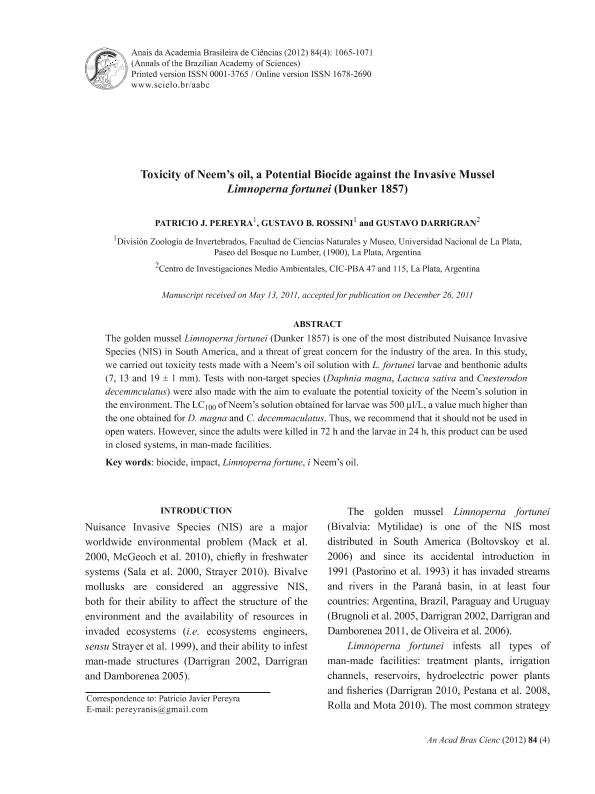Artículo
The golden mussel Limnoperna fortunei (Dunker 1857) is one of the most distributed Nuisance Invasive Species (NIS) in South America, and a threat of great concern for the industry of the area. In this study, we carried out toxicity tests made with a Neem’s oil solution with L. fortunei larvae and benthonic adults (7, 13 and 19 ± 1 mm). Tests with non-target species (Daphnia magna, Lactuca sativa and Cnesterodon decemmculatus) were also made with the aim to evaluate the potential toxicity of the Neem’s solution in the environment. The LC100 of Neem’s solution obtained for larvae was 500 µl/L, a value much higher than the one obtained for D. magna and C. decemmaculatus. Thus, we recommend that it should not be used in open waters. However, since the adults were killed in 72 h and the larvae in 24 h, this product can be used in closed systems, in man-made facilities. O Mexilhão dourado Limnoperna fortunei (Dunker 1857) é uma das espécies invasoras melhor distribuídas na América do Sul, sendo motivo de grande preocupação para a indústria local. Neste estudo, nós realizamos ensaios de toxicidade de soluções de Óleo de Neem em larvas e adultos bentônicos de L. fortune (7, 13 e 19 ± 1 mm). Com o objetivo de avaliar o potencial tóxico do Óleo de Neem no ambiente também foram realizados testes com organismos não alvo (Daphnia magna, Lactuca sativa e Cnesterodon decemmculatus). A LC100 da solução de Neem para larvas foi 500 µl/L, um valor muito superior ao obtido para D. magna e C. decemmaculatus. Desta forma, nossa recomendação é que este óleo não deve ser utilizado em ambientes naturais abertos. No entanto, uma vez que os adultos morreram em 72h e as larvas em 24h, este produto pode ser utilizado em sistemas fechados construídos pelo homem.
Toxicity of Neem’s oil, a potential biocide against the invasive Mussel Limnoperna fortunei (Dunker 1857)
Fecha de publicación:
12/2012
Editorial:
Academia Brasileira de Ciencias
Revista:
Anais Da Academia Brasileira de Ciencias
ISSN:
0001-3765
e-ISSN:
1678-2690
Idioma:
Inglés
Tipo de recurso:
Artículo publicado
Clasificación temática:
Resumen
Palabras clave:
Biocide
,
Impact
,
Limnoperna Fortunei
,
Neem'S Oil
Archivos asociados
Licencia
Identificadores
Colecciones
Articulos(CCT - LA PLATA)
Articulos de CTRO.CIENTIFICO TECNOL.CONICET - LA PLATA
Articulos de CTRO.CIENTIFICO TECNOL.CONICET - LA PLATA
Citación
Pereyra, Patricio Javier; Bulus Rossini, Gustavo Daniel; Darrigran, Gustavo Alberto; Toxicity of Neem’s oil, a potential biocide against the invasive Mussel Limnoperna fortunei (Dunker 1857); Academia Brasileira de Ciencias; Anais Da Academia Brasileira de Ciencias; 84; 4; 12-2012; 1065-1071
Compartir




